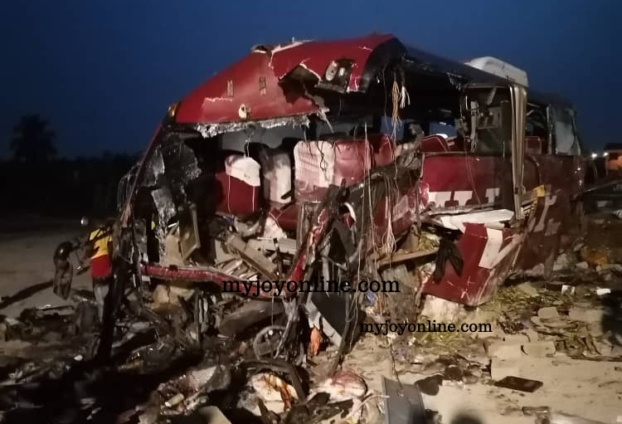Road traffic crashes are avoidable and so it is unacceptable when we continue to lose lives through them. Over the past week, a number of crashes were recorded in the country.
Paramount among them is the crash which occurred at Akim Asafo in the Eastern Region on the Accra – Kumasi highway which resulted in the death of at least nineteen people.
From the report, the crash occurred through a head-on collision involving two buses around 1:30 am on Friday, February 26, 2021.
The road traffic crash statistics at the Building and Road Research Institute of the Council for Scientific and Industrial Research (CSIR-BRRI), Kumasi indicate that head-on collision is the second most predominate cause of road traffic fatalities after vehicular-pedestrian collisions.
Head-on collisions accounted for almost one-quarter (23.4%; 485 deaths) of all fatalities in the year 2019 and yet, the number of people killed through head-on collisions could have been higher if under-recording from the data source is accounted for.
The fatality index, that is, the number of people killed as a proportion of all the people injured is very high in head-on collisions.
Using the 2019 figures, 16 out of 100 casualties died from head-on collisions whilst, for example, 8 out of 100 casualties died from rear-end collisions.
In traffic engineering, service measures used to assess the performance of a two-lane highway include the percent time-spent following a vehicle or being in a platoon.
Anyone who travel on the Accra – Kumasi highway is aware of the fact that in a significant amount of time, motorist will have to follow slow moving vehicles as there is limited overtaking possibilities because of the high traffic volume on the highway.
Drivers, after following slow moving vehicles for a while become agitated and try to overtake with the slightest of opportunity.
This, sometimes, results in wrongful overtaking manoeuvres causing head-on collisions with vehicles from the opposing traffic stream.
A journey which is supposed to take four hours, sometimes, take six hours because of the high incidence of time-spent following other slow-moving vehicles.
From road safety perspective, it is illogical to allow two vehicles, traveling at say 90 km/h to by-pass each other with just a thin centreline marking separating them.
Occupants of the vehicle will be punished unduly with the least mistake from the driver, and this, will not be allowed in the aviation industry.
For instance, a fatigued driver dozing off could move to the opposing lane resulting in a collision.
Headlight glare, from the opposing traffic stream, can result in temporary blindness causing the driver to move into the other lane.
The United Nations declared the second Decade of Road Safety Action 2021-2030 in August 2020 which aims to reduce road fatalities and injuries by 50% by the year 2030.
The action plan identified infrastructure investment as a key pillar in reducing the overall risk associated with road traffic deaths.
One of the key issues for the increase and high rate of road traffic death is lack of forgiving road infrastructure.
This is defined as injury limitation through engineering measures in anticipation of road user behaviour as the human being is bound to make mistakes.
Economically, it is not practical to dualize all our highways.
Even the developed countries have not been able to do this.
However, major or high-volume roads such as the Accra-Kumasi highway need to be dualized to eliminate the high incidents of head-on collisions and reduce travel time.
The cost of these road traffic crashes comprising loss of productive hours (lost output), administrative cost (incurred by the police in handling these crashes), medical cost, property damage cost (damage to the vehicle, goods in the vehicle and roadside furniture) and the intangible cost of grief, pain and suffering is too much for the country to bear.
The government needs to invest in developing our road infrastructure and more so, that the Accra-Kumasi highway must be dualized now to prevent the unacceptably high incidence of road traffic mortalities and injuries on the road.
****
The author is a Transport Consultant and a Senior Research Scientist
Latest Stories
-
Photos from DW-JoyNews street debate on ‘galamsey’
35 mins -
Mimmy Yeboah: Blending heritage with global sophistication, confidence redefined through couture
50 mins -
Akufo-Addo commissions 97-km Tema-Mpakadan railway line
1 hour -
Majority requests recall of Parliament
2 hours -
Kanzlsperger and Professor Quartey support WAFA with medical Donation
2 hours -
Gideon Boako donates 10 industrial sewing machines to Yamfo Technical Institute
2 hours -
‘Golden Boy’ Abdul Karim Razak honored at WAFU-B general assembly
2 hours -
Buipewura Jinapor secures Vice Presidential position in National House of Chiefs with record votes
2 hours -
2024 election: I want results to come out like ‘milk and honey’ – Toobu
2 hours -
Ghana’s Henry Bukari hands over chairmanship of ECOWAS Brown Card Council of Bureaux
2 hours -
Residents of Dome-Kwabenya on edge ahead of December elections
3 hours -
Moffy drops new single ‘Wo’, blending culture and modernity
3 hours -
Don’t bring soldiers to polling stations – Martin Kpebu
3 hours -
Ogyeahohuo Yaw Gyebi II retained as President of National House of Chiefs
4 hours -
Embrace ICT to fit in digital world – Ho NYA boss to youth
4 hours

